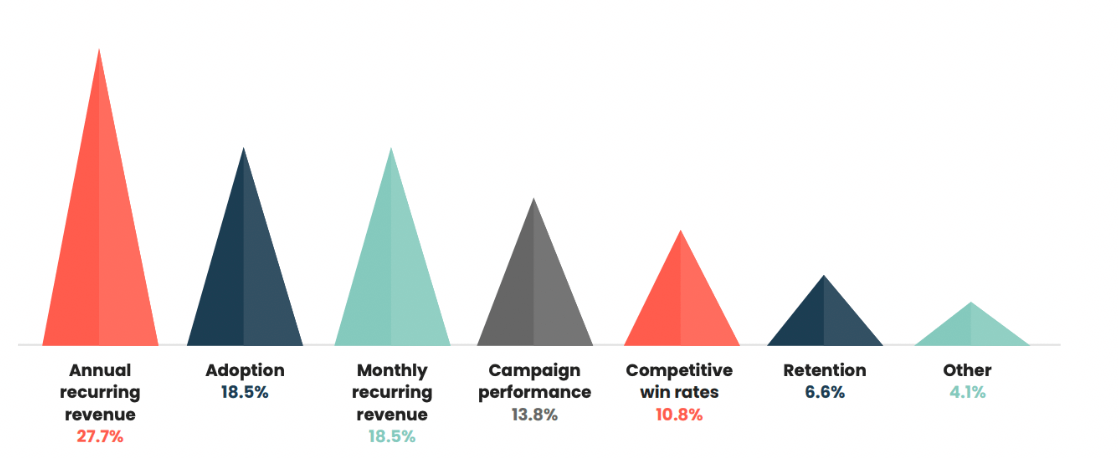This article is based on Devon and Erica’s discussion at the Product Marketing Summit in Denver, 2023. Product Marketing Alliance members can watch the session in its full glory here.
In this article, we'll be diving into the realm of product marketing, examining its strategic functions, and exploring how we can leverage it to achieve OKRs.
We'll also delve into some key metrics that are currently being used to measure product marketing's effectiveness. However, we need to acknowledge up front that there's no definitive blueprint for measuring success in this area.
First, let us introduce ourselves. We’re Devon O'Rourke, Founder and Managing Partner of Fluvio, and Erica Foster, Senior Product Marketing Consultant at Fluvio – a product marketing consulting firm.
We work hand in hand with various companies and get an inside view of the strategies and metrics tech companies are using to measure product marketing. And being a consulting company, we're often asked about our performance – as we’re sure you are too.
During this piece, we’ll hone in specifically on:
- How product marketing teams measure their success
- Sharing success metrics with other teams
- How to ensure you hit your goals
- How to get ongoing stakeholder buy-in
How product marketing teams measure their success
As a starting point, let's take a look at the recent State of Product Marketing Leadership Report. This resource presents a wealth of data on how product marketing is measured.
We're particularly interested in how leaders tie product marketing to revenue. The report finds that annual recurring revenue, product adoption, and monthly recurring revenue top the list of OKRs linking product marketing to revenue.

We’re happy to see that annual recurring revenue is the number-one way that product marketing teams measure their revenue impact. It's broad, but the impact of our work often takes over a year to become apparent to the business, so it's challenging to tie our efforts to anything less substantial than that.
It's no surprise that revenue emerges as such a significant focus for PMMs. However, working with a broad spectrum of products and industries, we’ve seen that the methods clients use to connect revenue to product marketing vary a lot. We've seen anything from personas linked to leads, to sales enablement programs tied to closed deals.
Adoption is another interesting metric to focus on because it can be interpreted in so many different ways.
For instance, are we discussing feature adoption or product usage – perhaps through MAU/DAU metrics (monthly average users to daily average users)? Regardless of the interpretation, it's clear why adoption has a secure spot on this list.
Now, depending on whether you're reporting into the product or marketing team, your perspective on metrics can change pretty dramatically. If you're rolling into a product team, you're likely looking at things like product adoption metrics or usage metrics.
In this setup, you not only have access to that data but also collaborate closely with product teams. These teams are invested in your success and stand by you during product launches. They help you understand release timelines or anything that might impact your launch.
But let's be clear; this isn't always the case. If you're part of a marketing team, your success metrics and partnerships could look very different.
Not only does your reporting structure influence your success criteria, but your business model plays a part too. Whether you’re in a B2B or a B2C product marketing org affects how you gauge success.
In B2C, it can be quite a struggle to track your success as a product marketer. In our experience, it’s much easier for B2B product marketing orgs to show and articulate their value; it's generally tied to some sort of revenue goal or win rates, which can easily be broken down and measured.
Meanwhile, in B2C you have to attach product marketing’s success to that of other partner teams – even more so than in B2B.
Sharing success metrics with other teams
Regardless of the business model, shared metrics among different teams are common. A good example is the win/loss metric. Product marketing often uses this as a success metric, but it's heavily influenced by the sales team. In fact, there aren't many pure product marketing metrics tied to success.
All this leads us to one question: can we measure success purely from a product marketing perspective?
It’s a tough one. Everything we do relies on other teams. That's why it’s so important to develop soft skills like emotional intelligence and collaboration. All these other teams are our extended arms – we can't really achieve anything without them.

Here’s another interesting graph from the State of Product Marketing Leadership Report. It focuses on the OKRs that leaders use to measure team performance, with win rates and leads influenced by PMM content coming out on top.


 Follow us on LinkedIn
Follow us on LinkedIn
